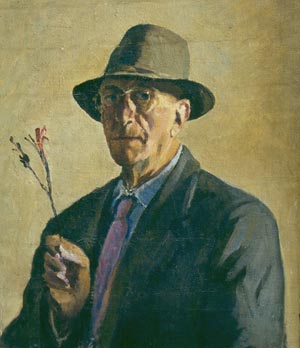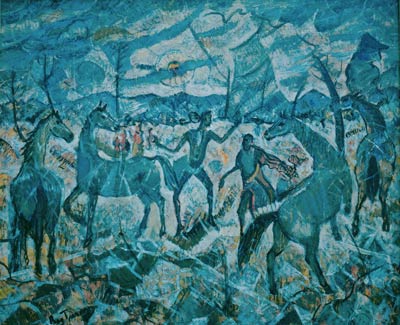BAFA © 2010. All material here is copyrighted. See conditions above. |
Reginald Turvey
painter, South Africa
|

Self-portrait with Hat, Oil on canvas, 54 x 43 cm,
by Reginald Turvey.
|
Reginald Turvey was born on a farm in Ladybrand (on the border of Lesotho), a descendent of pioneer Englishmen who came in the first wave of settlers in 1820. His father was a prosperous landowner and Reg was sent to study at Grey College in Bloemfontein. He never graduated as the headmaster persuaded his father to send Reg to London for art training. In 1903 he travelled with his parents around Europe and then was left with an allowance to attend the Slade School of Art.
He was 21 when he entered the Slade and on the first day met the 16 year old Bernard Leach who became his best friend and main inspiration in his life.
Bernard Leach has said that he does not think he had any influence upon Turvey as an artist. "I was interested in line," he said, "and Reggie in colour texture. He loved painting in itself and was a born colourist." ( page 2, Reginald Turvey / Life and Art, by Lowell Johnson, George Ronald Publishing, U.K.)
|
In 1904 Turvey won a prize in portrait painting and in his early years painted a number of portraits, but he excelled in landscapes. Reg was very self-critical as a student and between 1909 and 1920 he and Bernard Leach exchanged many letters expressing their artistic thoughts. Some of these are reproduced in the book Reginald Turvey / Life and Art.
In 1909 Leach settled in Japan and as a gift from his father, Turvey went to join Leach. However the lifestyle and the weather didn't agree with him and so he reluctantly agreed to return to his family in South Africa to assist on the farm. He was now 29, with no income and hated farming.
|

The Challenge, Oil on canvas, 49 x 60 cm, by Reginald Turvey.
|
In 1913 his father decided to move to Kenya and farm there, taking the family with him. Reg's job was to shoot game for food. Then his father died but Reg was not able to sell the farm until 1917. Marrying in 1924, having sold the farm he could now go and set up a studio in St Ives, England opposite Leach's home.
The next 16 years were fulfilling for Turvey. He had companionship, painted fulltime and had a relatively happy family life. When Leach moved to Totnes in 1932 as resident potter at Dartington Hall, the Turvey family moved to be nearby. The American painter, Mark Tobey was also teaching at Dartington Hall and so for the next eight years the three artists had a lot of contact with each other. They heard about the Bahá´í Faith from Mark, with Reg becoming a Bahá´í in 1935 and Bernard following in 1937. They made a pact to meet again in London 1963 for the centenary celebration of the Declaration of Bahá'u'lláh.
During these years Turvey exhibited in St. Ives, London and in Durban (South Africa). Then he had to move back to South Africa in 1940 because their son was ill and wartime England didn't have the special food he needed.
So he stored 200 paintings at Dartington and at 58 years of age moved to Eerste Rivier near Cape Town and then moved to Johannesburg two years later. The next ten years were difficult. His life was saddened by poor sales of his work, lost money in a number of property ventures and a divorce. He was a lonely man. Then in 1953 everything changed. Four Persian Bahá´ís arrived looking for him. They informed him that at the request of Shoghi Effendi a number of Bahá´ís were moving to South Africa. He was overjoyed as he had had no Bahá´í contact since leaving England. So he lived with the William Sears family for a number of years, in a congenial spiritual atmosphere with a studio in which to paint. He participated in numerous local exhibitions from 1953 onwards. Then the 1964 exhibitions finally brought him critical acclaim, where most works were sold, two being purchased by the National Gallery in Cape Town. He was 82. By 1965 arthritis and failing eyesight brought an end to active painting and he entered a nursing home in 1966, the same year of another triumphal exhibition in Johannesburg.
On several occasions I (a href="../j/johnsonl.htm">Lowell Johnson) asked Reg what influence the Bahá´í Faith had on his life. He said it gave him contentment. His paintings reflect it. Turvey's works are not sentimental and he almost never painted overtly Bahá´í themes. He was not strongly attached to his paintings and rarely gave them titles, leaving it to those who exhibited them. For example, the painting in oils inspired by the story of Tahirih was entitled by the exhibitor "Rima" and thereafter Reg referred to the painting by that name. His symbolic paintings from the mid 30's onwards of an Eden -in which humanity and animal are at one, show a marked change from his earlier more descriptive themes. His imagery developed towards a more naive or simple style and eventually simplications that were almost abstract, not unlike the 'white-writing' of Mark Tobey's work. His compositions became tapestries of intertwining calligraphic shapes in pale and opalescent tones. His paintings do not reflect the times he lived in, although he was fully aware of the problems of society. The closest he came to social commentary was in the painting, "Nightmare" and another titled "Crossing the Donga" depicting a black and a white horse and an African family standing under a huge shadow looking out into typical South African landscape, framed by a horizion in lighter colours suggestive of hope. Increasingly it is recognized that in his work, spanning over six decades he forged a significant tie between South Africa and international art.
Excerpts and adapted from the book, Reginald Turvey / Life and Art, by a href="../j/johnsonl.htm">Lowell Johnson, George Ronald Publishing, U.K., with permission from the author and publisher.
|
- Announcement, an exhibition of his paintings and a bursary in his name, BAFA newsletter, December 1993
|

Arts Dialogue, Dintel 20, NL 7333 MC, Apeldoorn, The Netherlands
email: bafa@bahai-library.com
|
|

